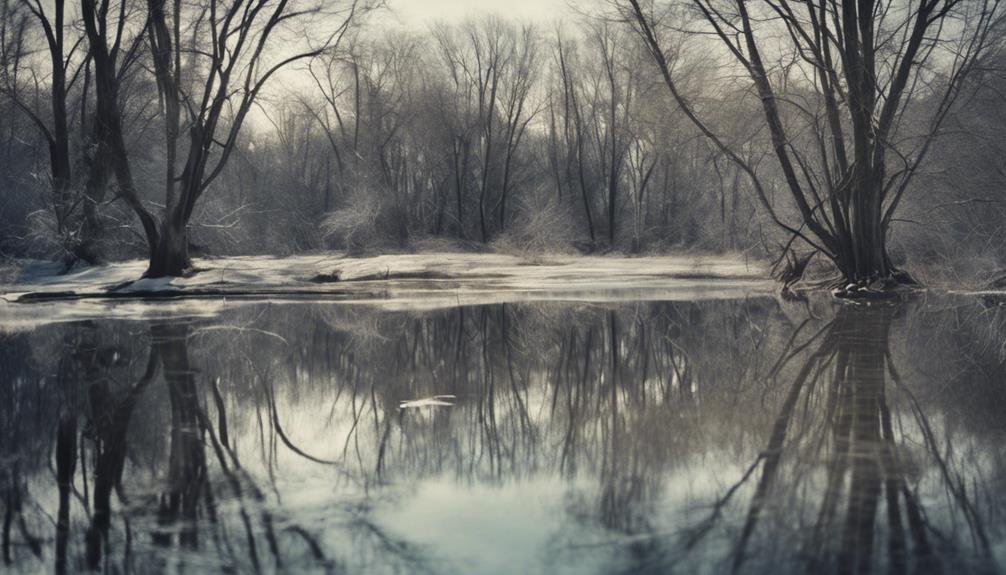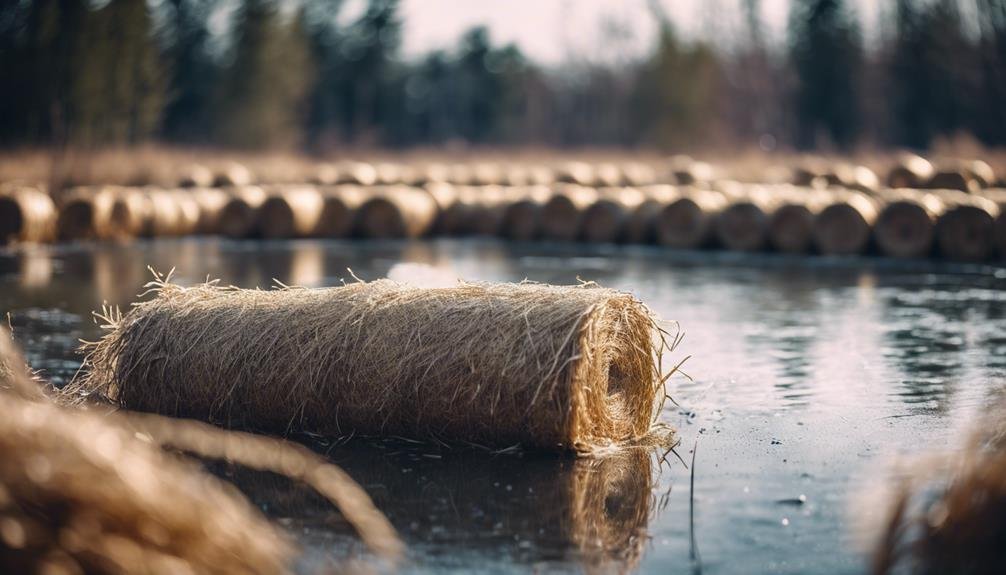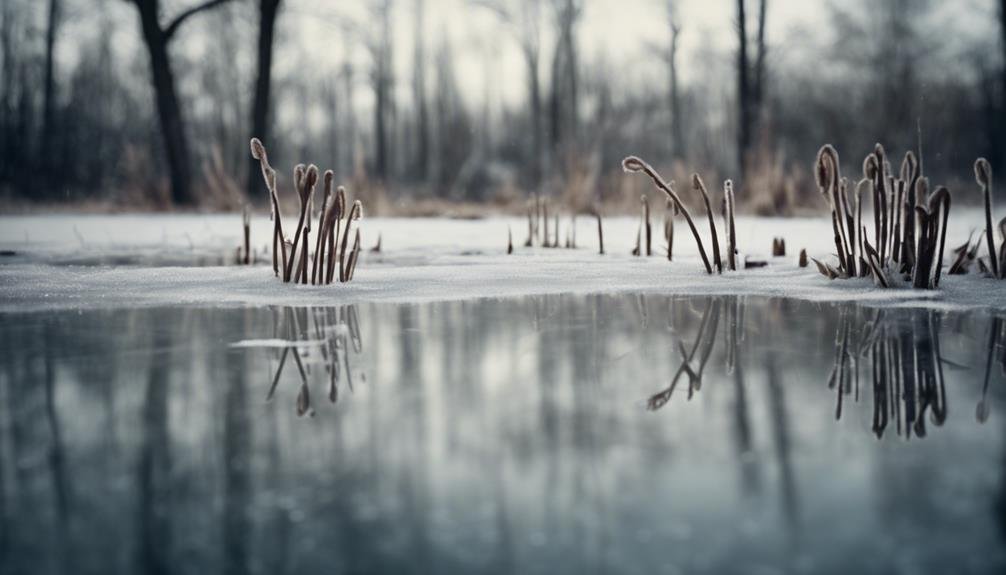To ensure winter pond safety, it's crucial to regularly check the thickness of the ice, use appropriate tools, and inspect for weak spots.
Removing snow strategically helps keep key areas clear, while aeration prevents harmful runoff. By aerating the water, insulating the pond edges, and creating access points for wildlife, you can protect the aquatic ecosystem effectively.
Insulating plants with mulch and covering surfaces will help them survive the cold season. It's essential to conduct routine water quality tests, maintain filtration systems, and trim foliage to ensure the pond's well-being during winter.
These precautions are vital for maintaining the health of the pond until the arrival of warmer weather.
Ice Thickness Monitoring
Winter pond care includes regularly checking the thickness of the ice on the surface to ensure it can support weight safely. It's recommended to have at least 4 inches (10 cm) of ice for walking and 8-12 inches (20-30 cm) for light vehicles like snowmobiles or ATVs.
To measure thickness, tools like an auger, ice chisel, or cordless drill can be used to create test holes in different areas of the pond. Ice thickness may vary due to factors like water depth, currents, and shade. Look for signs of weakness like cracks, slush, or discoloration that indicate thinner areas to avoid.
Regular monitoring of ice thickness is crucial for safety during winter activities on the pond. It ensures that the ice is strong enough to support any weight placed on it, preventing accidents and injuries.
Snow Removal Strategies
Removing snow from ponds in winter is essential to maintain oxygen levels and promote a healthier environment for aquatic life. Different snow removal strategies should be employed based on the size of the pond and access available.
For small backyard ponds, simple tools like a roof rake, shovel, or de-icer can be used to gently push or scoop snow off the frozen surface.
In the case of larger ponds, heavy equipment such as a snow blower, plow, or tractor may be necessary for efficient snow removal. Safety should always be a top priority, including testing the thickness of the ice, wearing appropriate protective gear, and avoiding working alone.
It's important to clear primary areas first, such as around aerators or the deepest sections of the pond, to prevent dangerous ice buildup and maintain a conducive aquatic environment.
Regularly removing snow from ponds not only ensures the safety of the water body but also allows sunlight to penetrate, aiding in the overall health of the pond. By following these snow removal strategies and safety precautions, pond owners can help preserve the well-being of their aquatic ecosystems throughout the winter months.
Preventing Hazardous Runoff

To prevent harmful runoff from entering ponds in winter, it's crucial to avoid using salt or chemical deicers near water bodies as they can harm aquatic life and pollute water sources. Instead, opt for environmentally friendly deicing alternatives.
Additionally, make sure to clear snow and ice away from storm drains and ditches to prevent contaminated meltwater from flowing directly into the pond. Installing sediment barriers like silt fences or straw bales around the pond's perimeter can help capture any runoff before it reaches the water, safeguarding the pond from pollutants.
Regular inspections and maintenance of stormwater management systems are also essential to ensure they're functioning correctly and effectively preventing polluted runoff from entering the pond. By taking these precautions, we can protect our ponds and the surrounding environment from the harmful effects of winter runoff.
Aerating Frozen Ponds
Before aerating a frozen pond, it's crucial to first assess the thickness of the ice. Maintaining the aeration system plays a key role in ensuring adequate oxygen levels and preventing fish fatalities. Adhering to safety protocols and following the manufacturer's guidelines are essential when operating aerators on ponds covered with ice.
Ice Thickness Check
Consistently checking the thickness of the ice in our pond is crucial to ensure proper aeration during the winter months and to maintain safety. By using an ice auger or chisel to create holes at different spots, we can monitor the ice thickness effectively. The holes should be at least 8 inches wide to allow for sufficient air exchange. It's recommended to check the ice thickness on a weekly basis and keep a log for reference. Remember that thick ice doesn't always mean it's safe, as conditions can vary.
To determine if the ice is safe for walking, it's important to check the depth at multiple locations and drill new holes as needed. Typically, ice that's 4 inches or less is unsafe for walking. For safe exploration, aim for ice that's at least 8-12 inches thick and clear. It's also wise to wear a life jacket and have safety equipment like rope and picks on hand. Checking with local authorities for current ice conditions is a good practice to ensure safety.
Aeration System Maintenance
To ensure our pond's water remains well-oxygenated in winter, it's crucial to maintain our aeration system properly. Regularly check that the aerator is running smoothly and providing sufficient air flow. A malfunctioning aerator can result in low oxygen levels, posing a threat to our fish's health and survival.
Inspect the airline tubing for any cracks or blockages that could impede air flow. Opt for a winter-specific aerator designed to withstand freezing temperatures and prevent ice buildup that can obstruct the intake. This proactive approach helps prevent the accumulation of harmful gases like methane under the ice and promotes water oxygenation by breaking up stratified layers through circulation.
Clear any snow or debris covering the aerator vent regularly to maintain its effectiveness. By prioritizing the upkeep of our aeration system, we can safeguard our pond inhabitants through the challenging winter season.
Insulating Pond Edges

Insulating pond edges is crucial for maintaining optimal water temperatures during winter months. To effectively insulate your pond, consider using a combination of leaves, straw bales, and foam boards.
Start by spreading a 6-inch layer of leaves or straw around the perimeter of the pond to create a natural insulating barrier. Next, place foam boards vertically along the outer edge of the pond, securing them tightly to prevent heat loss. Cover the foam boards with another layer of leaves or straw to enhance insulation. Additionally, you can add an extra layer of protection by draping burlap or geotextile fabric over the insulation to prevent it from being blown away by the wind.
Proper insulation helps regulate water temperature, preventing drastic fluctuations that can stress or harm fish and other aquatic life. By taking the time to insulate your pond, you're ensuring a healthy and thriving ecosystem even during the coldest winter days.
Consider these simple steps to protect your pond and its inhabitants throughout the winter season.
Wildlife Safety Measures
When designing a pond, it's crucial to consider the safety of both the aquatic life within it and the wildlife that may visit.
Creating gradual entry points with gravel or stones along the pond's edges ensures that small animals like birds, chipmunks, and raccoons can access the water without the risk of injury or drowning.
For larger wildlife such as deer or moose, installing ramps or platforms made of sturdy materials like wood or plastic can help them escape if they accidentally fall into the pond.
Regular maintenance is essential to keep these access points clear of ice and snow during the winter.
These measures not only enhance the beauty of your pond but also promote the well-being of local wildlife.
Pond Plant Protection

To protect our pond plants during the winter, it's crucial to choose hardy varieties that can withstand the cold and employ effective insulation techniques.
Opting for cold-resistant aquatic plants and insulating them with layers of material or by submerging their pots can help them survive the harsh winter weather.
This preparation ensures that our beloved pond plants stay healthy and vibrant for the next growing season.
Hardy Plant Varieties
To protect hardy pond plants from freezing temperatures, it's essential to safeguard their root systems during harsh winter conditions. Certain varieties like water lilies, lotus, cattails, and hardy water iris can typically survive in the pond over winter if the water is deep enough to keep their roots insulated.
However, in extremely cold climates, even these hardy plants may require additional protection. One approach is to wrap the crown and root zone with insulating materials such as burlap or foam boards. Adding a floating de-icer or aerator can also help prevent the pond from freezing completely.
When spring arrives, it's important to remove any protective coverings to allow the plants to start growing again. By providing proper winter care, our hardy pond plants can endure the cold and flourish in the following season.
Insulating Pond Plants
Insulating our pond plants in winter is crucial for protecting their delicate roots and ensuring their growth in spring. To keep our aquatic plants safe, we should cover the pond's surface with a thick layer of mulch or insulating material. This layer acts as a barrier that prevents the water from freezing completely, allowing the plant roots to stay dormant but alive beneath the ice.
Applying a few inches of mulch like straw or leaf litter effectively insulates the pond's surface. Alternatively, using styrofoam sheets or specially designed boards for pond insulation can also work well. These materials float on the water, trapping heat and preventing the pond from freezing solid.
It's important to remember to leave a small opening in the insulation for gases to escape. Decaying organic matter releases gases that can get trapped beneath the ice, potentially harming our aquatic pets.
Seasonal Pond Maintenance
Ensuring our pond remains healthy during the winter months requires proper seasonal maintenance in four key areas.
Firstly, we'll focus on water quality by testing and adjusting pH levels, ammonia, nitrites, and dissolved oxygen content. Maintaining the ideal water chemistry is crucial to prevent algae blooms and protect our fish.
Next, we'll clean the filtration system, including filters, pumps, and tubing, to ensure optimal water circulation. Proper filtration is essential for removing debris and preventing stagnation.
In terms of plant care, we'll trim dead foliage and insulate hardy plants to protect their root systems throughout the winter.
Lastly, we'll take care of our fish by gradually lowering water temperatures to reduce their activity. This helps slow down their metabolism, decreasing feeding needs and waste production.
Conclusion
Taking proper care of your pond during the winter is crucial for maintaining a healthy aquatic environment and preventing potential hazards. It's important to regularly check the thickness of the ice covering your pond to ensure safety.
Clearing away snow buildup helps prevent excessive weight on the surface that can lead to cracks or breaks. Additionally, it's essential to avoid toxic runoff from chemicals or pollutants that can harm the water and its inhabitants.
Aerating the frozen surface of the pond can help maintain oxygen levels for fish and other wildlife during the winter months. Insulating vulnerable edges with materials like straw or blankets can protect plants and prevent damage from freezing temperatures.
Safeguarding resident wildlife by providing shelters or food sources can also help them survive the cold season.
Properly maintaining plants in and around the pond is key to ensuring their survival and promoting a balanced ecosystem. By following these winter care tips diligently, you can minimize risks and ensure a thriving habitat that will be ready to flourish when spring arrives.

